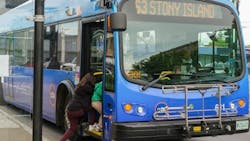CTA, CDOT launch Chicago's first Better Streets for Buses Plan
The Chicago Transit Authority (CTA) and the Chicago Department of Transportation (CDOT) has launched the city’s first Better Streets for Buses (BSB) Plan, which lays the groundwork for improved bus services citywide through ongoing investments in street, signal and sidewalk infrastructure–all designed to achieve faster and more reliable bus service, improved access to bus stops and better bus stops. The plan supports key transportation goals of Chicago Mayor Brandon Johnson’s administration, including improving bus reliability and coordination of infrastructure investments to improve transit.
“The Better Streets for Buses plan was crafted after listening to the transportation needs of Chicago residents,” said Mayor Johnson. “Chicagoans have a right to accessible public transportation and it is important that we continue to deliver improvements to better connect our communities – creating a better, stronger and safer Chicago.”
“The city of Chicago now has a framework to develop an organized program of projects—both small and large scale—that will improve the bus riding experience now and for generations to come,” said CTA President Dorval R. Carter Jr. “Getting to the bus, the wait at the bus stop and the ride on the bus are all impacted by various aspects of streetscape design and signal systems and this plan will help us better plan and redesign these elements to meet today’s transit needs and ensure that public transit bus services remain the most equitable, affordable and accessible means of transit in all neighborhoods throughout the city.”
The BSB Plan, which was created with input solicited through a public planning process, includes a network of 17 corridors across the city where improvements would be focused, and a “toolbox” of 19 potential street treatment options for enhancing the public way. Proposed plans for each corridor are intended to facilitate a better bus riding experience through measures such as enhanced bus stops, bus priority traffic signals and dedicated bus lanes.
“Better Streets for Buses lays the groundwork for making strategic investments in our streets, sidewalks, signals and other public infrastructure to improve every step of the rider’s experience,” said Acting Commissioner of CDOT Tom Carney. “CDOT and CTA will continue to closely collaborate on implementing this plan, which will help lead to a more equitable transportation system and improve bus reliability, accessibility and comfort.”
During the public outreach process held in 2022, CTA and CDOT received feedback from more than 1,300 individuals throughout the city via the project website, a series of virtual public and community meetings, email, phone, text and written comment cards. Feedback provided via the public meetings was a key element in helping guide key transit advocates, community stakeholders, and other agencies in selecting the network of bus service corridors for the BSB Plan. Other factors taken into consideration in developing the plan include data relating to equity, bus ridership and mode share, whether or not a bus corridor serves areas not served by rail and overall geographic completeness and connectivity.
"During the last 20 years, average CTA bus speeds have slowed by nine percent and we know slow bus speeds make the bus less reliable and more expensive to operate. Better Streets for Buses expands on the vision put forth in Mayor Johnson's Transition Report to create a robust network of bus priority streets throughout Chicago,” said Amy Rynell, executive director of the Active Transportation Alliance. “We look forward to supporting the implementation of true transit priority streets to create a more equitable and reliable bus riding experience for all Chicagoans. We stand ready to support CTA, CDOT and the city in prioritizing making that vision a reality, as the economic and environmental health of our region depends on this investment in the bus riding experience."
CTA notes the BSB Plan does not assign specific “tools” to each corridor, rather it offers a menu of improvements that can be applied depending on the needs of a specific corridor. As a major next step toward implementation of robust bus priority projects, CTA and CDOT have secured a competitive grant from Cook County’s Invest in Cook program, which will allow the agencies to conduct additional public outreach, develop specific concepts and advance design for at least three corridors identified in the BSB Plan.
Implementation of additional and complementary bus service improvement projects will be ongoing through existing CTA-CDOT programs, such as the Bus Priority Zones (BPZ) program. The BPZ Program consists of smaller scale street treatment projects that prioritize buses in heavily traveled corridors to improve bus service reliability across the entire route.
The development of the BSB Plan was supported by a $300,000 Unified Work Plan grant administered by the Chicago Metropolitan Agency for Planning.
